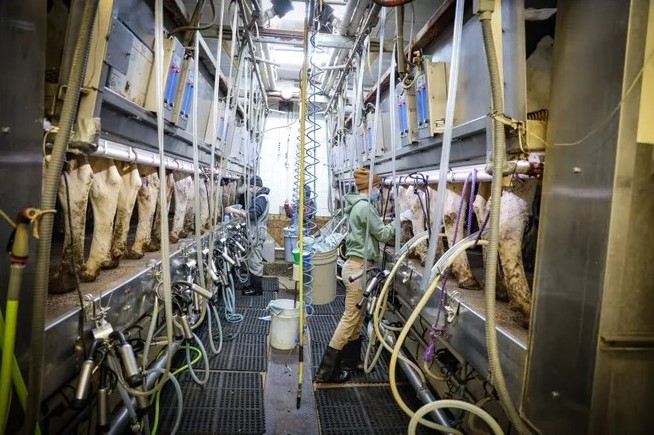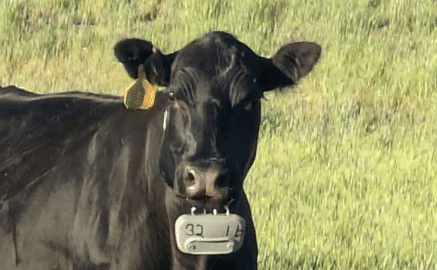STURGIS, S.D. – In just a few days, the number of states with dairy herds testing positive for Highly Pathogenic Avian Influenza (HPAI), a disease that is highly contagious and often deadly in poultry, caused by highly pathogenic avian influenza A (H5) and A (H7) viruses, also known as bird or avian flu, has grown from nine to 12.
The Wyoming Department of Agriculture (WDA) confirmed the presence of the virus in dairy cattle on June 7. Other states reporting outbreaks in the last week include Minnesota on June 6 and Iowa on June 5.
“The Wyoming Livestock Board encourages all dairy producers to closely monitor their herd and contact their herd veterinarian immediately if their cattle appear symptomatic,” said Hallie Hasel, Wyoming State Veterinarian. “The primary concern with this diagnosis is on-dairy production losses, as the disease has been associated with decreased milk production. The risk to cattle is minimal and the risk to human health remains very low.”
Testing has confirmed the presence of bird flu in more than 80 dairy herds throughout the country, according to the CDC.
Since late March, the virus has been detected in herds in Colorado, Idaho, Kansas, Michigan, New Mexico, North Carolina, Ohio, South Dakota and Texas. Three dairy workers, one in Texas and two in Michigan have tested positive for the H5N1 virus but have since recovered.
WHO officials stress that the risk to the general population is low.
Continued U.S. Food & Drug (FDA) testing finds no active bird flu virus in variety of dairy products or ground meat.
“USDA, Center for Disease Control, and other agencies continue to emphasize that pasteurization kills bacteria and viruses, like influenza, and that these milk and dairy products are safe to consume,” said Doug Miyamoto, Director of the WDA. “This is a very low risk to human health and the WDA will continue our normal regulatory efforts of the commercial dairy industry in Wyoming to help ensure the continued safety of the dairy products under inspection.”
The WDA and WLSB have been, and will continue to coordinate with federal and state partners to monitor this emerging issue.
 News Stories Tracing The Emergence of H5N1 In Dairy Cattle In The U.S.
News Stories Tracing The Emergence of H5N1 In Dairy Cattle In The U.S.
Since it was first isolated in 1963, the highly pathogenic bird-flu virus H5N1 has caused outbreaks in domestic and wild birds around the world, and it has occasionally infected mammals such as seals and foxes. On 25 March, US health officials announced that H5N1 had been detected in dairy cows for the first time.
Scientists had not previously suspected that dairy cattle could easily become infected with bird flu, because the animals were thought to lack the receptor that allows the virus to enter their cells. But reports of sick dairy cattle with inflamed udders raised suspicions that the virus can infect the animals’ mammary glands.
New studies support this idea, showing that cells lining cows’ milk glands have abundant receptors for H5N1 and that this bird-flu strain proliferates in these cells rather than in the respiratory tract, which influenza viruses usually infect. “The mammary glands seem to be the main target of viral replication,” says Diego Diel, a virologist at Cornell University in Ithaca, New York, who co-authored one of the studies. But some infected cows also experience mild respiratory symptoms, Diel and his colleagues report.
The findings suggest that minimizing exposure to raw milk could be an important way to prevent transmission. But the enormous scale of US milking operations means that stopping the spread will be complicated, says Juergen Richt, a veterinary virologist at Kansas State University in Manhattan.
To begin with, the same milking equipment is used on many cows, offering the virus ample opportunity to spread. And milking is messy. Milk often spills onto the floor, and when equipment that suctions to cows’ udders is released, the liquid sprays out in every direction. This endangers dairy workers according to Seema Lakdawala, an influenza virologist at Emory University School of Medicine in Atlanta, Georgia. She added, “That isn’t normally a big deal for people who work there — they’re used to it — but that means they’re bombarded with virus.”
Data collected by Lakdawala and her colleagues support her worries: infectious virus can persist in milk droplets and on milking machines for hours, they found. On the basis of these data, she urges farms to consider disinfecting equipment between uses, installing proper ventilation and offering protective equipment, such as face shields, to farm workers to prevent further spread.











